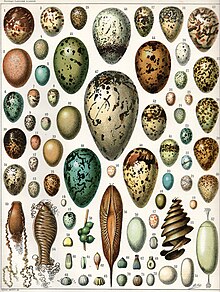Oviparity

Oviparous animalsareanimalsthatreproduceby depositingfertilizedzygotesoutside the body (known aslayingorspawning) in metabolically independentincubationorgansknown aseggs,which nurture theembryointomovingoffspringsknown ashatchlingswith little or no embryonic development within the mother. This is the reproductive method used by most animal species, as opposed toviviparousanimals that develop the embryos internally and metabolically dependent on the maternal circulation, until the mother givesbirthto livejuveniles.
Ovoviviparityis a special form of oviparity where the eggs are retained inside the mother (but still metabolically independent), and are carried internally until they hatch and eventually emerge outside as well-developed juveniles similar to viviparous animals.
Modes of reproduction
[edit]The traditional modes of reproduction include oviparity, taken to be the ancestral condition, traditionally where either unfertilisedoocytesor fertilised eggs are spawned, andviviparitytraditionally including any mechanism where young are born live, or where the development of the young is supported by either parent in or on any part of their body.[1]
However, the biologistThierry Lodérecently divided the traditional category of oviparous reproduction into two modes that are distinguished on the basis of the relationship between thezygote(fertilised egg) and the parents:[1][2]
- Ovuliparity,in whichfertilizationisexternal,is taken to be the ancestral condition as a rule; the eggs that the female releases into the environment contain unfertilisedoocytes,and the male fertilizes them by releasingspermsin proximity to the eggs. In whichever form they are laid, the eggs of most ovuliparous species contain a substantial quantity ofyolkto support the growth and activity of the embryo after fertilization, and sometimes for some time after hatching as well.[1]Among thevertebrates,ovuliparity is common amongfishesand mostamphibians.It also occurs amongcnidarians,ctenophores,echinoderms,molluscsand several otheraquatic animalphylaas well.[1]
- (True)oviparity,in which fertilization isinternal,is taken to be the derived condition, whether the maleinjects the sperminto the femaleintromittentlyor whether she actively or passively picks it up — the female lays eggs containing zygotes with a substantial quantity of yolk to feed the embryo while it remains in the egg, and in many species to feed it for some time afterwards. The egg is not retained in the body for most of the period of development of the embryo within the egg, which is the main distinction between oviparity andovoviviparity.[1]Oviparity occurs in allbirds,mostreptiles,some fishes, and mostarthropods.Amongmammals,monotremes(four species ofechidna,and theplatypus) are uniquely oviparous.
In all but special cases of both ovuliparity and oviparity, the overwhelming source of nourishment for the embryo is thenutrientsstored in the yolk, pre-deposited in the egg by thereproductive systemof the mother (thevitellogenesis). Offspring that depend on yolk in this manner are said to belecithotrophic,which literally means "feeding on yolk"; as opposed tomatrotrophy,where the maternal circulation provides for the nutritional needs. Distinguishing between the definitions of oviparity and ovuliparity necessarily reduces the number of species whose modes of reproduction are classified as oviparous, as they no longer include the ovuliparous species such as most fish, most frogs and many invertebrates. Such classifications are largely for convenience and as such can be important in practice, but speaking loosely in contexts in which the distinction is not relevant, it is common to lump both categories together as just "oviparous".
References
[edit]External links
[edit]- Oviparityat the U.S. National Library of MedicineMedical Subject Headings(MeSH)
- Oviparity – an overviewat sciencedirect

